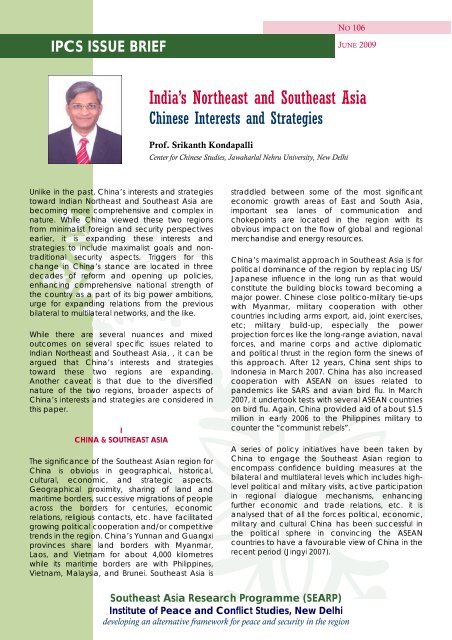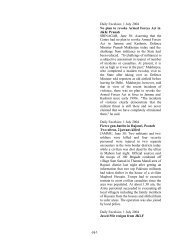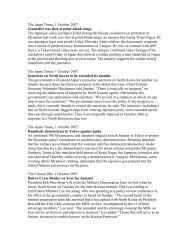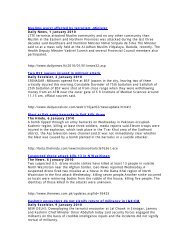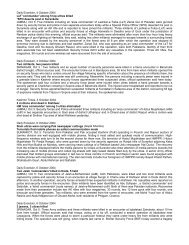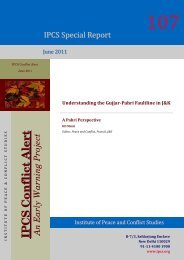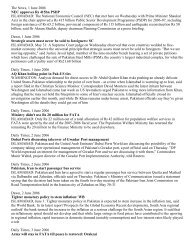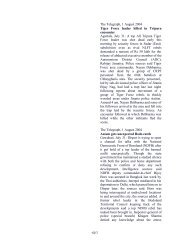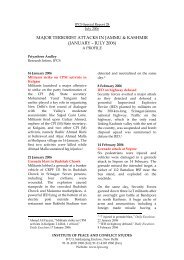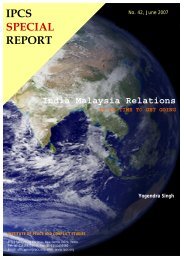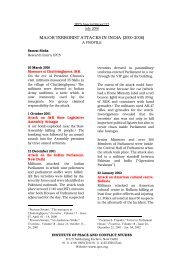India's Northeast and Southeast Asia - Institute of Peace and Conflict ...
India's Northeast and Southeast Asia - Institute of Peace and Conflict ...
India's Northeast and Southeast Asia - Institute of Peace and Conflict ...
Create successful ePaper yourself
Turn your PDF publications into a flip-book with our unique Google optimized e-Paper software.
IPCS ISSUE BRIEF<br />
NO 106<br />
JUNE 2009<br />
India’s <strong>Northeast</strong> <strong>and</strong> <strong>Southeast</strong> <strong>Asia</strong><br />
Chinese Interests <strong>and</strong> Strategies<br />
Pr<strong>of</strong>. Srikanth Kondapalli<br />
Center for Chinese Studies, Jawaharlal Nehru University, New Delhi<br />
Unlike in the past, China’s interests <strong>and</strong> strategies<br />
toward Indian <strong>Northeast</strong> <strong>and</strong> <strong>Southeast</strong> <strong>Asia</strong> are<br />
becoming more comprehensive <strong>and</strong> complex in<br />
nature. While China viewed these two regions<br />
from minimalist foreign <strong>and</strong> security perspectives<br />
earlier, it is exp<strong>and</strong>ing these interests <strong>and</strong><br />
strategies to include maximalist goals <strong>and</strong> nontraditional<br />
security aspects. Triggers for this<br />
change in China’s stance are located in three<br />
decades <strong>of</strong> reform <strong>and</strong> opening up policies,<br />
enhancing comprehensive national strength <strong>of</strong><br />
the country as a part <strong>of</strong> its big power ambitions,<br />
urge for exp<strong>and</strong>ing relations from the previous<br />
bilateral to multilateral networks, <strong>and</strong> the like.<br />
While there are several nuances <strong>and</strong> mixed<br />
outcomes on several specific issues related to<br />
Indian <strong>Northeast</strong> <strong>and</strong> <strong>Southeast</strong> <strong>Asia</strong>, , it can be<br />
argued that China’s interests <strong>and</strong> strategies<br />
toward these two regions are exp<strong>and</strong>ing.<br />
Another caveat is that due to the diversified<br />
nature <strong>of</strong> the two regions, broader aspects <strong>of</strong><br />
China’s interests <strong>and</strong> strategies are considered in<br />
this paper.<br />
I<br />
CHINA & SOUTHEAST ASIA<br />
The significance <strong>of</strong> the <strong>Southeast</strong> <strong>Asia</strong>n region for<br />
China is obvious in geographical, historical,<br />
cultural, economic, <strong>and</strong> strategic aspects.<br />
Geographical proximity, sharing <strong>of</strong> l<strong>and</strong> <strong>and</strong><br />
maritime borders, successive migrations <strong>of</strong> people<br />
across the borders for centuries, economic<br />
relations, religious contacts, etc. have facilitated<br />
growing political cooperation <strong>and</strong>/or competitive<br />
trends in the region. China’s Yunnan <strong>and</strong> Guangxi<br />
provinces share l<strong>and</strong> borders with Myanmar,<br />
Laos, <strong>and</strong> Vietnam for about 4,000 kilometres<br />
while its maritime borders are with Philippines,<br />
Vietnam, Malaysia, <strong>and</strong> Brunei. <strong>Southeast</strong> <strong>Asia</strong> is<br />
straddled between some <strong>of</strong> the most significant<br />
economic growth areas <strong>of</strong> East <strong>and</strong> South <strong>Asia</strong>,<br />
important sea lanes <strong>of</strong> communication <strong>and</strong><br />
chokepoints are located in the region with its<br />
obvious impact on the flow <strong>of</strong> global <strong>and</strong> regional<br />
merch<strong>and</strong>ise <strong>and</strong> energy resources.<br />
China’s maximalist approach in <strong>Southeast</strong> <strong>Asia</strong> is for<br />
political dominance <strong>of</strong> the region by replacing US/<br />
Japanese influence in the long run as that would<br />
constitute the building blocks toward becoming a<br />
major power. Chinese close politico-military tie-ups<br />
with Myanmar, military cooperation with other<br />
countries including arms export, aid, joint exercises,<br />
etc; military build-up, especially the power<br />
projection forces like the long-range aviation, naval<br />
forces, <strong>and</strong> marine corps <strong>and</strong> active diplomatic<br />
<strong>and</strong> political thrust in the region form the sinews <strong>of</strong><br />
this approach. After 12 years, China sent ships to<br />
Indonesia in March 2007. China has also increased<br />
cooperation with ASEAN on issues related to<br />
p<strong>and</strong>emics like SARS <strong>and</strong> avian bird flu. In March<br />
2007, it undertook tests with several ASEAN countries<br />
on bird flu. Again, China provided aid <strong>of</strong> about $1.5<br />
million in early 2006 to the Philippines military to<br />
counter the “communist rebels”.<br />
A series <strong>of</strong> policy initiatives have been taken by<br />
China to engage the <strong>Southeast</strong> <strong>Asia</strong>n region to<br />
encompass confidence building measures at the<br />
bilateral <strong>and</strong> multilateral levels which includes highlevel<br />
political <strong>and</strong> military visits, active participation<br />
in regional dialogue mechanisms, enhancing<br />
further economic <strong>and</strong> trade relations, etc. it is<br />
analysed that <strong>of</strong> all the forces political, economic,<br />
military <strong>and</strong> cultural China has been successful in<br />
the political sphere in convincing the ASEAN<br />
countries to have a favourable view <strong>of</strong> China in the<br />
recent period (Jingyi 2007).<br />
<strong>Southeast</strong> <strong>Asia</strong> Research Programme (SEARP)<br />
<strong>Institute</strong> <strong>of</strong> <strong>Peace</strong> <strong>and</strong> <strong>Conflict</strong> Studies, New Delhi<br />
developing an alternative framework for peace <strong>and</strong> security in the region
INDIA’S NORTHEAST AND SOUTHEAST ASIA<br />
PAGE 2<br />
By 2002, China signed declarations <strong>of</strong> cooperation<br />
with the ASEAN <strong>and</strong> has either solved or in the<br />
process <strong>of</strong> solving l<strong>and</strong> <strong>and</strong> maritime disputes.<br />
While such “normalisation” <strong>of</strong> relations between<br />
China <strong>and</strong> <strong>Southeast</strong> <strong>Asia</strong>n countries has several<br />
other facets <strong>and</strong> differences, certain long-term<br />
underst<strong>and</strong>ing between the two is being worked<br />
out. China concluded a FTA with the ASEAN that is<br />
to be in place between 2010 <strong>and</strong> 2012, signed a<br />
treaty <strong>of</strong> amity <strong>and</strong> cooperation <strong>and</strong> tripartite<br />
agreement with Vietnam <strong>and</strong> Philippines on South<br />
China Sea dispute, initiated defence cooperative<br />
measures, etc. China assiduously kept away the<br />
US from the late 2005 Kuala Lumpur, January 2007<br />
Cebu <strong>and</strong> Singapore meetings <strong>of</strong> the East <strong>Asia</strong>n<br />
Summit, while its initial efforts to keep away India<br />
<strong>and</strong> others were unsuccessful due to the pressures<br />
<strong>of</strong> Singapore <strong>and</strong> Japan.<br />
China-ASEAN trade is more than $150 billion,<br />
making China the ASEAN’s fifth largest trading<br />
partner <strong>and</strong> ASEAN the sixth largest trading<br />
partner for China. To facilitate further trade<br />
between the two, China <strong>and</strong> the ASEAN countries<br />
have agreed to give shape to the 2000 proposal<br />
<strong>and</strong> set up an FTA in late 2002. If realised by 2010<br />
(for the older members <strong>of</strong> ASEAN <strong>and</strong> 2015 for its<br />
“new” members), this would be the world’s<br />
biggest such zone, with estimates <strong>of</strong> a combined<br />
market <strong>of</strong> 1.7 billion people, regional GDP <strong>of</strong> $2<br />
trillion <strong>and</strong> international trade worth $1.2 trillion,<br />
that would place FTA next only to the North<br />
American Free Trade Area <strong>and</strong> the European<br />
Union. It is proposed to remove all tariff <strong>and</strong> nontariff<br />
barriers to goods <strong>and</strong> services, <strong>and</strong> provide<br />
for preferential treatment to the “new” ASEAN<br />
members so that they could catch up<br />
economically with the rest. The next substantive<br />
step came in July 2005, when China-ASEAN<br />
agreed to implement goods trade agreement. In<br />
addition to reduction in tariffs in 2005, next year<br />
witnessed signing <strong>of</strong> free trade deals. Further, in<br />
January 2007, both agreed to cut barriers to trade<br />
in services such as transport, tourism, <strong>and</strong><br />
telecommunications.<br />
Another issue is the energy <strong>and</strong> trade<br />
dependence <strong>of</strong> China on <strong>Southeast</strong> <strong>Asia</strong>. This issue<br />
China’s maximalist approach in <strong>Southeast</strong> <strong>Asia</strong><br />
is for political dominance <strong>of</strong> the region by<br />
replacing US/Japanese influence in the long run<br />
as that would constitute the building blocks<br />
toward becoming a major power.<br />
has a potential to divide both India <strong>and</strong> China in<br />
the long term. Several Chinese reports indicate<br />
the concerns on Chinese dependence on the seal<br />
lanes <strong>of</strong> communications in <strong>Southeast</strong> <strong>Asia</strong>,<br />
specifically Straits <strong>of</strong> Malacca’s. In 2008 China<br />
imported about 180 million tonnes <strong>of</strong> oil, nearly 80<br />
percent <strong>of</strong> which passed through these Straits. In<br />
addition, burgeoning trade with South <strong>Asia</strong>n <strong>and</strong><br />
other countries is largely dependent on these<br />
Straits. Nearly 25 percent <strong>of</strong> global shipping passes<br />
through the South China Sea. Any disruptions to<br />
these supply lines could drastically affect the oil<br />
prices but also the economies <strong>of</strong> several countries.<br />
China is exploring alternate routes like access to<br />
the Indian Ocean through Myanmar. China<br />
concluded defence agreement with Malaysia<br />
<strong>and</strong> has been actively pursuing a “string <strong>of</strong> pearls”<br />
strategy in the Indian Ocean Region <strong>and</strong><br />
contiguous areas. However, some Chinese do<br />
recognise the Indian role in stabilising the situation.<br />
there is a possibility <strong>of</strong> cooperating with India in<br />
the fields <strong>of</strong> intelligence <strong>and</strong> technology to<br />
mitigate the challenges posed in the Straits.<br />
(Renfei 2004). Due to this, China conducted joint<br />
naval operations with India in November 2003 at<br />
Shanghai, December 2005 at Cochin, <strong>and</strong> regular<br />
port calls are being explored such as the Indian<br />
Naval visits to Qingdao in April 2007. Some believe<br />
that the launch <strong>of</strong> “string <strong>of</strong> pearls” strategy by<br />
China is to some extent linked to India’s Look East<br />
Policy (Khurana 2008). Besides, the Indian policy <strong>of</strong><br />
building a joint comm<strong>and</strong> at Andaman & Nicobar<br />
Isl<strong>and</strong>s has some bearing on the Chinese activity<br />
in <strong>Southeast</strong> <strong>Asia</strong>n region (Chaudhary 2007).<br />
II<br />
CHINA & INDIA’S NORTHEAST<br />
Distinct from the <strong>Southeast</strong> Region is the Indian<br />
<strong>Northeast</strong>, which is also contiguous to the southwestern<br />
regions <strong>of</strong> China. China’s interests <strong>and</strong><br />
strategies differ here on many issues, but<br />
fundamentally, sovereignty clashes over<br />
Arunachal Pradesh, national security concerns<br />
over indigenous peoples living in contiguous<br />
territories, etc remain similar. China’s interests in<br />
this region are broadly related to exp<strong>and</strong>ing<br />
physical connectivity, gaining access to the Indian<br />
Ocean, mitigating energy contingencies, <strong>and</strong><br />
evolving interdependencies for stabilising remote<br />
regions in the absence <strong>of</strong> progress in border talks<br />
with India. As a relatively more developed region,<br />
South-western portions <strong>of</strong> China could then have<br />
attained comm<strong>and</strong>ing position in this area. China<br />
had been assiduously exp<strong>and</strong>ing bilateral <strong>and</strong><br />
multilateral interactions in the region towards<br />
these objectives.<br />
IPCS ISSUE BRIEF
NO 106<br />
PAGE 3<br />
In order to realise this, China spearheaded in<br />
August 1999 the Kunming Initiative (Bangladesh-<br />
China-India-Myanmar grouping BCIM) with<br />
delegates from China, India, Myanmar <strong>and</strong><br />
Bangladesh participating. Subsequently, meetings<br />
were held at the respective capitals <strong>of</strong> these<br />
countries focusing on infrastructure development<br />
projects, tourism, economic development, etc.<br />
While China, Myanmar <strong>and</strong> Bangladesh<br />
appeared to stress Track 1 level, India prefers a<br />
Track 2 dialogue process underling the latter’s<br />
reservations.<br />
The BCIM area is about 2.12 million sq. km. (<strong>of</strong><br />
which the Indian northeast is about 255,000 sq.<br />
km) with a population <strong>of</strong> about 400 million (<strong>of</strong><br />
which there were about 30 million in the Indian<br />
north-east) <strong>and</strong> abundant natural resources<br />
connecting the under-developed markets <strong>of</strong> the<br />
Indian sub-continent with China <strong>and</strong> South East<br />
<strong>Asia</strong>. The “complementary” role <strong>of</strong> Chinese south<br />
western resources (metallurgy, chemical,<br />
electromechanical, textile, tobacco, paper<br />
making, etc) with that <strong>of</strong> the Indian northeast<br />
potential (in minerals, agriculture, aquaculture<br />
<strong>and</strong> electronics), Myanmar (l<strong>and</strong>, forests, oil,<br />
precious stones) <strong>and</strong> Bangladesh (natural gas,<br />
coal, water resources, garments) are stressed in<br />
this grouping.<br />
Domestic business <strong>and</strong> political considerations in<br />
China preceded the BCIM proposal. Chinese<br />
south-western provinces <strong>of</strong> Sichuan <strong>and</strong> Yunnan<br />
are in the throes <strong>of</strong> modernizing their economies.<br />
However the Sichuan initiative was lost (along with<br />
nearly 5 million migrant labourers) to the Special<br />
Economic Zones in the South-eastern Coastal<br />
Regions which is suitable for the export-oriented<br />
economic model. Nevertheless, following the<br />
current drive to open up the western regions the<br />
investment climate has been slowly shifting<br />
towards these south-western provinces. In<br />
addition, the State Owned Enterprises are either<br />
being consolidated into large groupings or are<br />
being sold to private entrepreneurs in the process<br />
<strong>of</strong> marketization. A large private entrepreneurs’<br />
exhibition was held at Kunming in 2001 for further<br />
development <strong>of</strong> the region. In this context, a<br />
railway line proposal linking interior south-western<br />
provinces to the nearest coastal regions<br />
(Myanmar, etc) for further export was made in<br />
1995 at the National People’s Congress in Beijing<br />
(coincidentally after China’s military Logistics<br />
Director Gen. Zhao Nanqi questioned whether<br />
Indian Ocean is India’s ocean in 1993!). It was<br />
argued that a railway line would be able to<br />
exp<strong>and</strong> trade volume, especially in iron <strong>and</strong><br />
phosphorous imports, as such current trade<br />
(conducted by the medium <strong>and</strong> low level trading<br />
China’s interests <strong>and</strong> strategies in India’s<br />
<strong>Northeast</strong> differ on many issues, but<br />
fundamentally, sovereignty clashes over<br />
Arunachal Pradesh, national security concerns<br />
over indigenous peoples living in contiguous<br />
territories, etc remain similar<br />
companies) is uneconomical by sea. Close<br />
economic <strong>and</strong> political cooperation between<br />
China <strong>and</strong> Myanmar resulted in developing roads<br />
<strong>and</strong> waterways from Yunnan to the Indian Ocean<br />
through the Irrawaddy River. Two railway routes<br />
identified include: Dali (Yunnan)- Tengchong <strong>and</strong><br />
Myitkyina (Myanmar)- Ledo (India); <strong>and</strong> Xiangyun<br />
<strong>and</strong> Ruili (Yunnan) - Lashio <strong>and</strong> M<strong>and</strong>alay<br />
(Myanmar) - Chittagong <strong>and</strong> Dhaka (Bangladesh)<br />
– Calcutta (India).<br />
The roadway construction project plans include<br />
the following: 1,472 km Ruili (Yunnan)- Bamuo to<br />
Rangoon (Myanmar); 540 km Heinnitang to<br />
Myitkyina- Stilwell Raod to Ledo (India); 730 km<br />
Ruili to Bamuo <strong>and</strong> Myitkyina to Stilwell Road to<br />
Ledo; 770 km Ruili to Bamuo <strong>and</strong> Tamu (Myanmar)<br />
to Imphal (India); Nagal<strong>and</strong> (India) – Myanmar;<br />
<strong>and</strong> India-China road - 200 kms <strong>of</strong> the Gongshang<br />
county (Yunnan) to Gecha county (Tibet) [built by<br />
1999] <strong>and</strong> about 200 kms from Chayu county<br />
(Tibet) to Lido (India) [incomplete]. The waterways<br />
projects include: Through Ilowai River from Yunnan<br />
to Muse to Bamuo port [length 1,563 km. <strong>and</strong><br />
width 600 meters; h<strong>and</strong>ling capacity 3.9 million<br />
tons] in Myanmar.<br />
Chinese <strong>of</strong>ficials assume that this economic<br />
cooperation would lead to “unity <strong>of</strong> the<br />
developing countries <strong>and</strong> [their] joint fight against<br />
hegemonies” <strong>and</strong> contribute to “establishing the<br />
new-multi-polar world order <strong>and</strong> safeguard<br />
[emphasis added] the peace <strong>and</strong> stability <strong>of</strong> <strong>Asia</strong><br />
<strong>and</strong> the world”. Upon the realization <strong>of</strong> the<br />
economic benefits flowing from these<br />
cooperative efforts, the four countries, according<br />
to Lai Xiaorong, are to set up a “companionship<br />
facing the 21st century”. In this context, an <strong>Asia</strong>n<br />
Forum was formed at Bo Ao in Hainan Province in<br />
2001 (attended by other members like Myanmar,<br />
Bangladesh, Pakistan <strong>and</strong> Nepal, though Indian<br />
Embassy <strong>of</strong>ficials at Beijing or New Delhi ignored<br />
the meeting initially). Broadly, this framework fits<br />
into the Chinese government’s overall strategic<br />
considerations <strong>of</strong> complete “normalization” in all<br />
fields <strong>of</strong> economic, social, <strong>and</strong> political aspects<br />
prior to solving the border problem with India.<br />
Development <strong>of</strong> infrastructure, especially transport<br />
routes, have been one <strong>of</strong> the crucial aspects <strong>of</strong><br />
SOUTHEAST ASIA RESEARCH PROGRAMME (SEARP)
INDIA’S NORTHEAST AND SOUTHEAST ASIA PAGE 4<br />
the BCIM agenda. The Trans <strong>Asia</strong>n Highway (TAH)<br />
was conceived in 1960 <strong>and</strong> has about 25 member<br />
countries with three (including Russia <strong>and</strong> Korea)<br />
expected to join in the near future. Its length is<br />
about 15,000 km. The Trans <strong>Asia</strong>n Railway (TAR)<br />
was conceived in 1959. However both TAH <strong>and</strong><br />
TAR faced problems with the outbreak <strong>of</strong><br />
Vietnam, Cambodian, Iran, <strong>and</strong> Iraq wars. A fresh<br />
impetus was given in the 1980s. However, BCIM<br />
has proposed several alternate routes from the<br />
one existing but under repair or at places missing.<br />
Bangladesh has proposed a short route that<br />
reduces the railway line by about 400 km from<br />
Kunming via Imphal to Dhaka. Huge investments<br />
are required either to construct or upgrade the<br />
TAH/TAR. As there is no significant trade in this<br />
region, the infrastructure cost may act as a<br />
deterrent for its further progress. Other related<br />
projects include those connecting to <strong>Southeast</strong><br />
<strong>Asia</strong>: Kunming to Singapore; Bangkok highway<br />
from Kunming (to be built by 2005); Lunming to<br />
Laos, etc. In this context the Indian government<br />
has shown some interest in the infrastructure<br />
development projects. The Shukla Commission<br />
Report [“Transforming the <strong>Northeast</strong>”] <strong>of</strong> March<br />
1977 advocated the concept <strong>of</strong> constructing a<br />
Trans-<strong>Asia</strong>n highway <strong>and</strong> railway linking Indian<br />
northeast with China through Myanmar. The BRO<br />
has constructed the 160 km Tamu-Kalewa-<br />
Kalemayo road at a cost <strong>of</strong> Rs 92 crores<br />
connecting Myanmar.<br />
Trade that follows from the construction <strong>of</strong><br />
transport routes is another area <strong>of</strong> concern for the<br />
BCIM. The <strong>of</strong>ficial trade figures among these<br />
countries reveal a definite rise. For instance, Indo–<br />
Myanmmar trade increased from Rs 444 cr in 1993-<br />
94 to about $995 million in 2008. Similarly, Indo-<br />
Bangladesh trade increased from Rs 1050 cr in<br />
1992-93 to $3.6 billion in 2008 <strong>and</strong> India-China<br />
trade from a nominal $ 3.5 billion in 2001 reached<br />
$50 billion in 2008. In the approximate border<br />
trade figures there has been significant un<strong>of</strong>ficial<br />
trade between India-Myanmar <strong>and</strong> Bangladesh.<br />
Through Moreh to Myanmmar the un<strong>of</strong>ficial trade<br />
figures are about Rs 2000 cr per annum, Champai<br />
<strong>and</strong> Lungwah to Myanmmar is about Rs 500 cr<br />
<strong>and</strong> 100 cr respectively <strong>and</strong> through West Bengal<br />
<strong>and</strong> Tripura to Bangladesh its Rs 1165 crores.<br />
IV<br />
CONCLUSIONS<br />
China is today facing several bottlenecks in<br />
pursuing its interests in <strong>Southeast</strong> <strong>Asia</strong> <strong>and</strong> in<br />
<strong>Northeast</strong> India. As mentioned earlier in this article,<br />
sovereignty factor had been important for the<br />
relative stalemate between China <strong>and</strong> these<br />
countries. Due to differences between the ASEAN<br />
members, China had been so far able to make<br />
some headway on South China Sea dispute. Not<br />
much progress have achieved in the Indian<br />
<strong>Northeast</strong> case due to security concerns <strong>of</strong> the<br />
Indian establishment as well as non-resolution <strong>of</strong><br />
border disputes. While the local government in<br />
Arunachal Pradesh had suggested opening up<br />
border trade points with Tibet, this was not<br />
acceptable to China. On the other h<strong>and</strong>, India is<br />
wary <strong>of</strong> the dependencies <strong>of</strong> the <strong>Northeast</strong><br />
Region given the relatively industrialised<br />
Southwestern Regions <strong>of</strong> China. In this situation,<br />
India had proposed direct links with <strong>Southeast</strong> <strong>Asia</strong><br />
(through Myanmar) or through the maritime<br />
dimensions rather than linking up with China. On<br />
the other h<strong>and</strong>, China has been lukewarm to the<br />
Indian proposals for pan-<strong>Asia</strong>n FTA as this might<br />
enhance Japan, Singapore, <strong>and</strong> other countries’<br />
leverages. Overall, despite the prospects for<br />
increasing trade <strong>and</strong> economic development,<br />
China’s interactions with <strong>Southeast</strong> <strong>Asia</strong> <strong>and</strong><br />
Indian northeast are fuelling concerns in some<br />
quarters <strong>of</strong> these regions.<br />
REFERENCES<br />
Zhang Lianfu <strong>and</strong> Pei Zhengxuan “21 shiji de Zhongguo<br />
yu Dongmeng guojia guanxi jiyu, tiaozhan,<br />
qianqing” [The relationship between China <strong>and</strong> ASEAN<br />
nations in the 21st Century: Opportunity, challenges <strong>and</strong><br />
prospects] Chaohu xueyan xuebao [Chaohu College<br />
Journal] 8.2.77. (2006): pp. 26-29.<br />
Xu Jingyi. “Lengzhan hou Zhongguo zai Dongnanya diqu<br />
shili yunyong: Zhongguo yu Dongmeng waijiao” [China’s<br />
wielding <strong>of</strong> strength in <strong>Southeast</strong> <strong>Asia</strong> in the post-Cold<br />
War: The foreign policy <strong>of</strong> China <strong>and</strong> ASEAN] Zhonggong<br />
Shijiazhuang Weidangxiao Xuebao [Journal <strong>of</strong> the Party<br />
University <strong>of</strong> Shijiazhuang Committee <strong>of</strong> the Communist<br />
Party] 9.4. (2007) pp. 29-32.<br />
“ASEAN, China agree to cut trade barriers” http://<br />
money.netscape.com/story/2007/01/14/asean-chinaagree-to-cut-trade-barriers<br />
Yang Renfei, “Maliujia haidao wentide zui xin fazhan ji dui<br />
Nanhai wenti de qishi” [Latest developments <strong>of</strong> the<br />
Malacca Straits issue <strong>and</strong> its inspiration for the South<br />
China issue] Dongnanya Zongheng [Around <strong>Southeast</strong><br />
<strong>Asia</strong>] (September 2004) pp. 38-42 <strong>and</strong> 54<br />
Gurpreet S. Khurana, “ China’s ‘String <strong>of</strong> Pearls’ in the<br />
Indian Ocean <strong>and</strong> Its Security Implications” Strategic<br />
Analysis, 32, No. 1, (January 2008) pp. 1-39<br />
SOUTHEAST ASIA<br />
RESEARCH PROGRAMME (SEARP)<br />
INSTITUTE OF PEACE AND CONFLICT STUDIES<br />
B-7/3, Safdarjung Enclave, New Delhi, India,<br />
110029, Tel: 91-11-4100 1900<br />
SEARP is supported by the SAEA Group,<br />
Singapore


